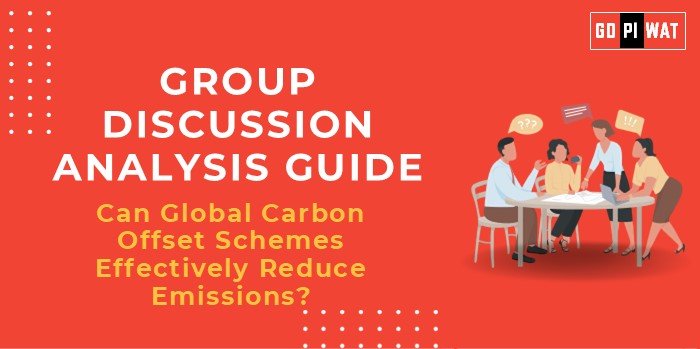📋 Group Discussion (GD) Analysis Guide: Can Global Carbon Offset Schemes Effectively Reduce Emissions?
🌍 Introduction to the Topic
Opening Context: “As nations rally to achieve net-zero goals, carbon offset schemes have emerged as a pivotal tool in combating climate change. However, questions about their effectiveness persist.”
Topic Background: Originating in the Kyoto Protocol, carbon offsets allow entities to compensate for emissions by funding projects that reduce CO₂ elsewhere. These include reforestation, renewable energy, and methane capture initiatives. Recent debates focus on their authenticity and impact amid growing climate emergencies.
📊 Quick Facts and Key Statistics
- Global Carbon Offset Market Size: Valued at $2 billion (2022), projected to grow to $200 billion by 2050.
- Emission Reduction: Offset schemes claim to mitigate 155 million tons of CO₂ annually.
- Participation: Over 2,000 companies globally partake in voluntary offset programs.
- Shortfall: Less than 2% of global emissions are currently offset through such schemes.
👥 Stakeholders and Their Roles
- Governments: Establish compliance markets, regulate standards.
- Corporations: Offset emissions as part of corporate social responsibility or compliance.
- NGOs: Validate and oversee offset projects, ensuring adherence to international standards.
- Communities: Benefit from projects like afforestation and clean energy but may also face displacement risks.
✨ Achievements and Challenges
- Achievements:
- Forest Conservation: Projects in Brazil and Indonesia reduced deforestation by over 25% in project zones.
- Renewable Energy Funding: Offset programs financed 8,000+ renewable energy projects globally.
- Corporate Accountability: Over 60% of Fortune 500 companies have committed to net-zero targets supported by offsets.
- Challenges:
- Additionality Issues: Many projects fail to prove they wouldn’t have occurred without offset funding.
- Verification Gaps: Lax standards have led to double counting and fraudulent credits.
- Global Comparisons: While the EU’s Emission Trading System succeeded in reducing emissions by 35% from 2005–2020, similar initiatives in Asia struggle due to enforcement gaps.
- Case Studies:
- Successful: Norway’s carbon tax-funded offsets reduced national emissions by 10% in five years.
- Controversial: Kenya’s afforestation project displaced indigenous communities, sparking criticism of ethical practices.
🔄 Structured Arguments for Discussion
- Supporting Stance: “Carbon offset schemes provide critical funding for renewable energy and forest conservation efforts, bridging the gap toward net-zero goals.”
- Opposing Stance: “Offsets allow corporations to delay substantial emission reductions, undermining climate goals.”
- Balanced Perspective: “While offsets address short-term emissions, they must complement systemic changes for long-term sustainability.”
✅ Effective Discussion Approaches
- Opening Approaches:
- Start with global emission data and the role of offsets in net-zero strategies.
- Highlight a key success story like Norway’s tax-funded offsets.
- Counter-Argument Handling:
- Acknowledge shortcomings like verification issues but propose solutions like blockchain-based monitoring.
📈 Strategic Analysis of Strengths and Weaknesses
- Strengths: Provides immediate solutions; funds diverse environmental projects.
- Weaknesses: Lacks transparency; additionality concerns.
- Opportunities: Blockchain for verification; mandatory offset schemes for large emitters.
- Threats: Regulatory loopholes; greenwashing risks.
🎓 Connecting with B-School Applications
- Real-World Applications:
- Discuss offsets in ESG project planning, operations management, or public policy.
- Sample Interview Questions:
- “What is the role of blockchain in making carbon offsets more reliable?”
- “How can businesses balance offsets and direct emission reductions?”
- Insights for B-School Students: Consider offset schemes as potential case studies for sustainable innovation.


